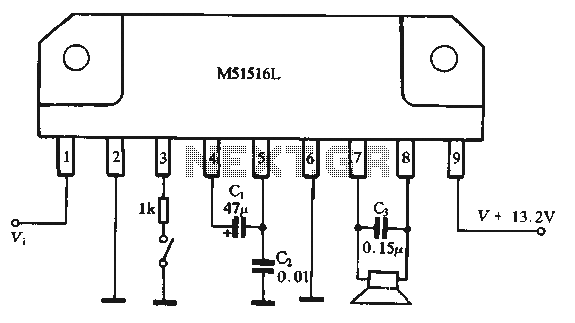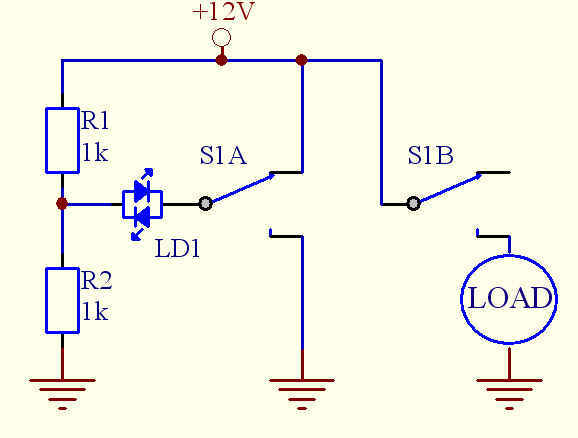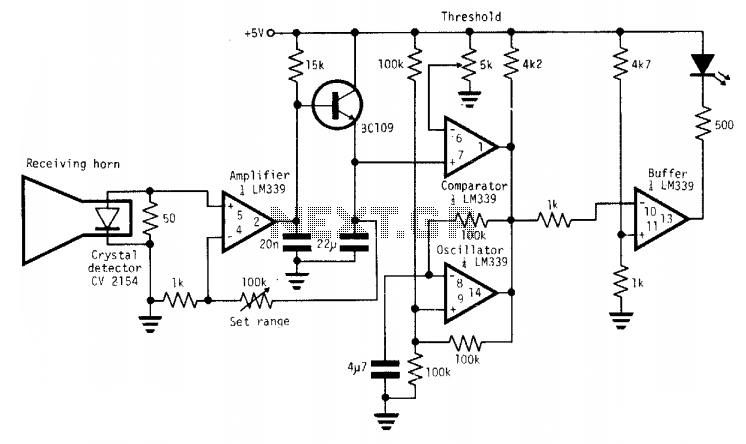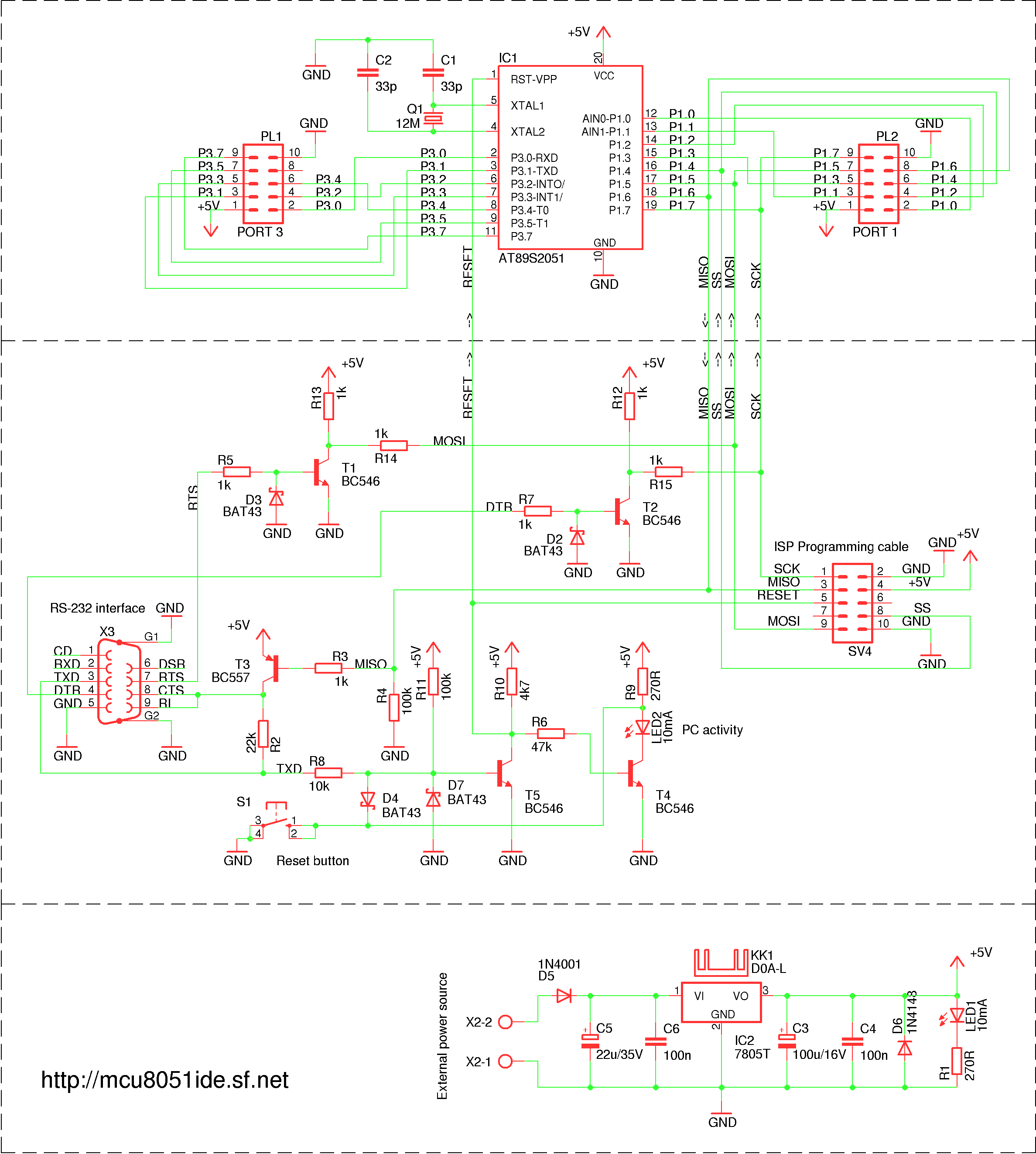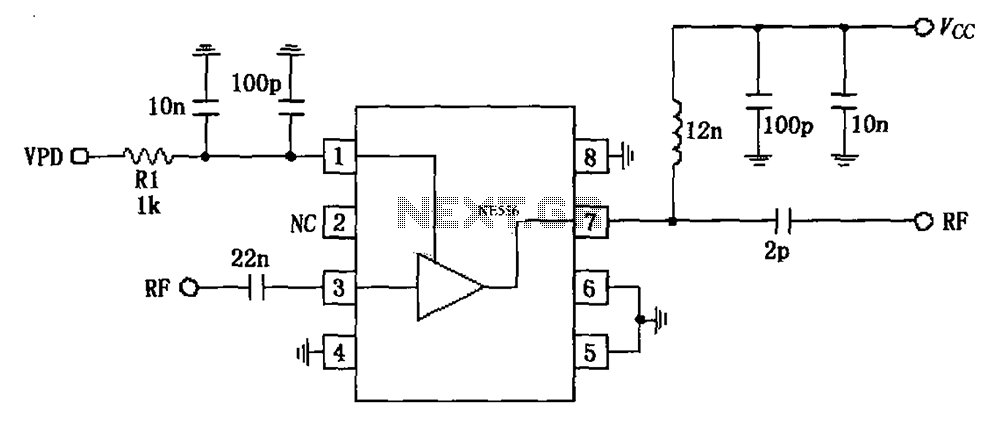
3D audio processing and application circuit LM4610
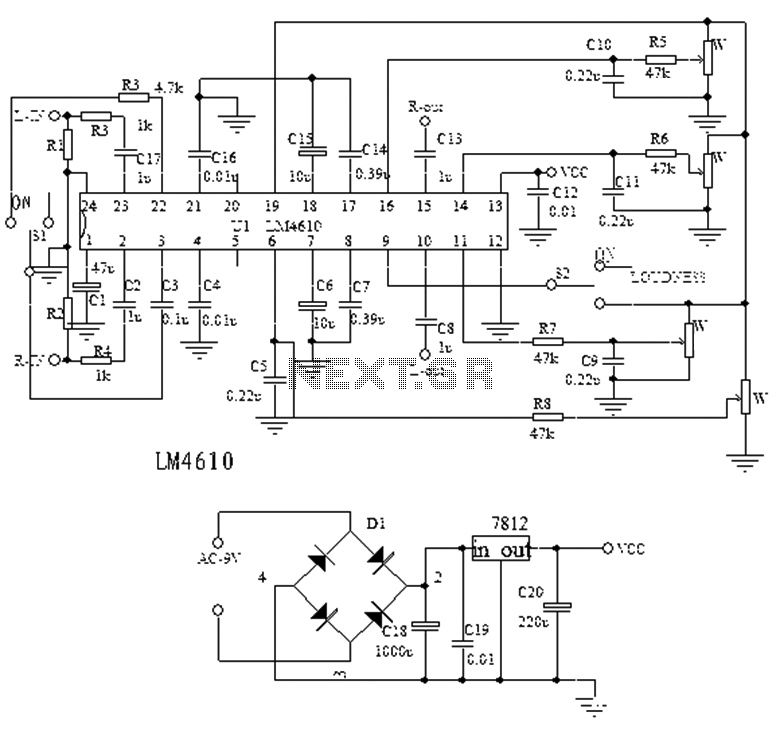
The LM4610 is a product from a US company, succeeding the LM1036, and represents a new class of high-end Hi-Fi tone integrated circuits (ICs). It serves as an ideal alternative to the LM1036, utilizing a two-channel DC voltage to regulate volume, treble, bass, and balance. The IC also enhances the 3D sound field broadening adjustment found in the LM1036 and includes a loudness switch to compensate for the human ear's characteristic curve at lower volumes.
Key Features of the LM4610 include:
1. Operating voltage: 9 to 16V
2. Current: 35mA
3. Input impedance: 30KΩ
4. Low output impedance: 20Ω
5. Treble adjustment range: 16dB at 16kHz
6. Bass adjustment range: 15dB at 40Hz
7. Balance adjustment range: 1 to 20dB
8. Volume adjustment range: 75dB
9. Signal-to-noise ratio (SNR): 80dB
10. Frequency response: 250kHz
11. Total harmonic distortion: 0.0003
The circuit principle is illustrated in the typical application circuit for the LM4610. The output at pin 19 provides a reference voltage of 5.4V, which is adjusted by four 47KΩ potentiometers to vary the voltage at each control pin, allowing for changes between 0 and 5.4V. This mechanism facilitates control over volume, tone, and balance. The 3D sound switch and loudness switch are represented by switches S1 and S2, respectively. The treble tone control is linked to capacitor Ct, while the bass control is associated with capacitor Cb. When the treble capacitance (Ct) is set to 0.01μF and the bass capacitance (Cb) is set to 0.39μF, the lift and attenuation amounts within the frequency range of 40Hz to 60Hz can achieve a maximum of 15dB.
The LM4610 is designed for applications requiring high fidelity audio management, making it suitable for advanced audio systems where precise control over sound characteristics is essential. The integration of features such as the loudness switch and 3D sound field adjustment enhances the listening experience, particularly at lower volumes where human perception of sound frequencies can vary. This IC is ideal for audiophiles seeking to optimize their audio setups with reliable and versatile tone control capabilities.LM4610 is a US company following the LM1036 NS after the launch of a new class of high-end HIFI tone IC, LM1036 is the ideal alternative, it is also the use of two-channel DC voltage to regulate the volume, treble, bass, balance. The IC also increase based on the LM1036s 3D sound field broadening adjustment, it comes with a loudness switch to compensate for the human ear characteristic curve when a small volume. LM4610 Key Features: (1) Operating voltage: 9 ~ 16V Current: 35mA input impedance is 30K, low output impedance of 20 Europe (2) Treble adjustment range: 16DB (16KHZ time) 3) Bass adjustment range: 15DB (40KHZ time) (4) balance adjustment range: 1 20DB (5) Volume adjustment range: 75DB (6) SNR: 80DB (7) Frequency Response: 250KHZ (8) Total harmonic distortion: 0.0003 Circuit principle: LM4610 typical application circuit shown below, LM4610s pin 19 output 5.4V reference voltage by four 47K potentiometer to adjust the voltage of each control pin, so that in between 0 5.4V change, thus to for volume, tone and balance control.
3D sound switch for the switch S1, S2 is equal loudness switch. LM4610 and treble tone control capacitor Ct, bass capacitor Cb related. When treble capacitance Ct = 0.01uF, bass capacitor Cb = 0.39uF, the lift amount and the amount of attenuation in the 40HZ-60HZ, 15dB range.
Key Features of the LM4610 include:
1. Operating voltage: 9 to 16V
2. Current: 35mA
3. Input impedance: 30KΩ
4. Low output impedance: 20Ω
5. Treble adjustment range: 16dB at 16kHz
6. Bass adjustment range: 15dB at 40Hz
7. Balance adjustment range: 1 to 20dB
8. Volume adjustment range: 75dB
9. Signal-to-noise ratio (SNR): 80dB
10. Frequency response: 250kHz
11. Total harmonic distortion: 0.0003
The circuit principle is illustrated in the typical application circuit for the LM4610. The output at pin 19 provides a reference voltage of 5.4V, which is adjusted by four 47KΩ potentiometers to vary the voltage at each control pin, allowing for changes between 0 and 5.4V. This mechanism facilitates control over volume, tone, and balance. The 3D sound switch and loudness switch are represented by switches S1 and S2, respectively. The treble tone control is linked to capacitor Ct, while the bass control is associated with capacitor Cb. When the treble capacitance (Ct) is set to 0.01μF and the bass capacitance (Cb) is set to 0.39μF, the lift and attenuation amounts within the frequency range of 40Hz to 60Hz can achieve a maximum of 15dB.
The LM4610 is designed for applications requiring high fidelity audio management, making it suitable for advanced audio systems where precise control over sound characteristics is essential. The integration of features such as the loudness switch and 3D sound field adjustment enhances the listening experience, particularly at lower volumes where human perception of sound frequencies can vary. This IC is ideal for audiophiles seeking to optimize their audio setups with reliable and versatile tone control capabilities.LM4610 is a US company following the LM1036 NS after the launch of a new class of high-end HIFI tone IC, LM1036 is the ideal alternative, it is also the use of two-channel DC voltage to regulate the volume, treble, bass, balance. The IC also increase based on the LM1036s 3D sound field broadening adjustment, it comes with a loudness switch to compensate for the human ear characteristic curve when a small volume. LM4610 Key Features: (1) Operating voltage: 9 ~ 16V Current: 35mA input impedance is 30K, low output impedance of 20 Europe (2) Treble adjustment range: 16DB (16KHZ time) 3) Bass adjustment range: 15DB (40KHZ time) (4) balance adjustment range: 1 20DB (5) Volume adjustment range: 75DB (6) SNR: 80DB (7) Frequency Response: 250KHZ (8) Total harmonic distortion: 0.0003 Circuit principle: LM4610 typical application circuit shown below, LM4610s pin 19 output 5.4V reference voltage by four 47K potentiometer to adjust the voltage of each control pin, so that in between 0 5.4V change, thus to for volume, tone and balance control.
3D sound switch for the switch S1, S2 is equal loudness switch. LM4610 and treble tone control capacitor Ct, bass capacitor Cb related. When treble capacitance Ct = 0.01uF, bass capacitor Cb = 0.39uF, the lift amount and the amount of attenuation in the 40HZ-60HZ, 15dB range.
Warning: include(partials/cookie-banner.php): Failed to open stream: Permission denied in /var/www/html/nextgr/view-circuit.php on line 713
Warning: include(): Failed opening 'partials/cookie-banner.php' for inclusion (include_path='.:/usr/share/php') in /var/www/html/nextgr/view-circuit.php on line 713

